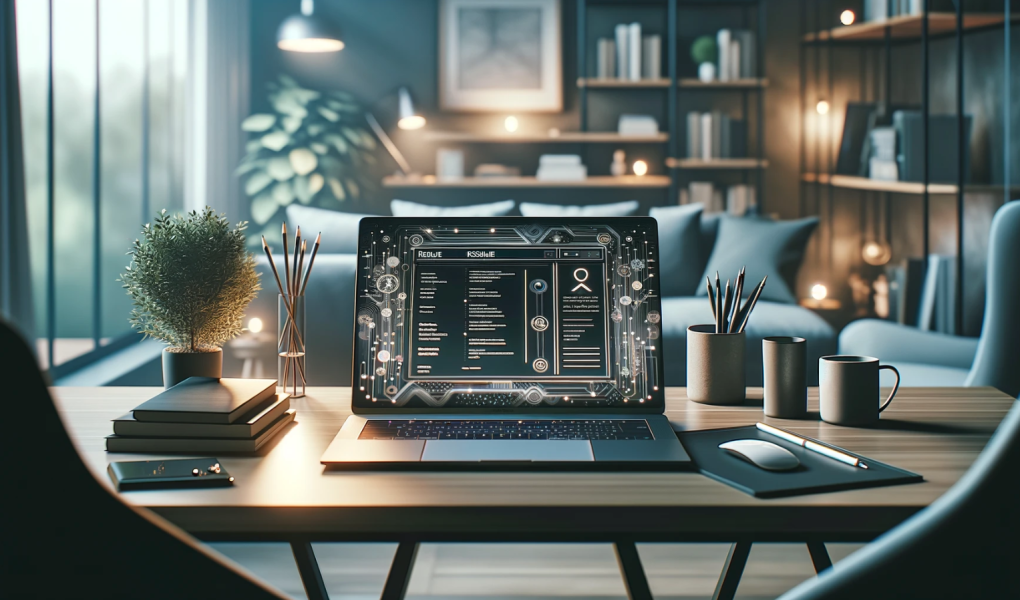Are you ready to get into the world of resumes, but with a twist?
Yes, we’re talking about using ChatGPT for your resume!
Sounds futuristic, right? Well, buckle up, because I’m about to take you on a highly informative journey on how to make your resume not just good, but out-of-this-world fantastic using ChatGPT.
What is ChatGPT?
Before we start flexing our resume muscles, let’s get the basics down. ChatGPT is a state-of-the-art language model developed by OpenAI. Think of it as your witty, AI-powered friend who knows a ton about creating resumes. It’s like having a career advisor, a writing assistant, and a comedian, all rolled into one (without the need to buy them coffee).
Why Use ChatGPT for Your Resume?
“Why should I use ChatGPT for my resume?” you ask. Well, let me count the ways:
- Expertise on Tap: ChatGPT has been trained on a vast array of texts, so it knows what works and what doesn’t in a resume.
- Personalization Wizard: It can help tailor your resume to specific job descriptions, making sure you stand out.
- Error Hunter: Say goodbye to typos and grammatical errors that make recruiters cringe.
- Time Saver: It’s quick, efficient, and doesn’t take coffee breaks.
Getting Started: ChatGPT Basics
Before we unleash the power of ChatGPT on your resume, let’s get acquainted with how it works. It’s super user-friendly – you type in your request, and voila, you have your answer.
But remember, it’s not a mind reader (yet), so be very clear with your instructions.
Creating Your Resume with ChatGPT
Alright, let’s get down to business.
Here’s how you can use ChatGPT to create a resume that will make recruiters do a double-take.
1. Understanding the Job Description
First up, understanding the job description. ChatGPT can help dissect the job listing to identify key skills and qualifications. Just copy-paste the job description, and ask ChatGPT to highlight the essentials. It’s like having a job description decoder!
2. Tailoring Your Experience
When it comes to crafting a resume, one size certainly does not fit all. Each job you apply for is unique, and your resume should reflect that.
This is where tailoring your experience becomes crucial, and ChatGPT enters as your personal assistant in this endeavour.
Understanding the Role of Tailoring
Tailoring your experience means aligning your resume with the specific requirements and preferences of the job you’re applying for. This includes highlighting relevant skills, experiences, and achievements that match the job description.
How ChatGPT Assists in Tailoring
- Analyzing Job Descriptions: Input the job description into ChatGPT, and it can analyze and extract key skills and qualifications that the employer is looking for. This serves as a roadmap for customizing your resume.
- Highlighting Relevant Experiences: Share your work history with ChatGPT. It can suggest how to rephrase and prioritize these experiences to align closely with the job requirements. For instance, if the job emphasizes leadership, ChatGPT can help you highlight your leadership experiences more prominently.
- Bridging the Gap: Sometimes, you might not see how your past experiences align with the new role. ChatGPT can assist by finding transferable skills and experiences in your background that are relevant to the job, even if they’re not immediately obvious.
- Keyword Optimization: ChatGPT can identify industry-specific keywords from the job description and suggest how to incorporate them naturally into your resume. This is crucial for passing Applicant Tracking Systems (ATS) and catching the recruiter’s eye.
- Customizing Achievements: ChatGPT can help reframe your achievements to match the job’s context. For instance, if the job requires a strong sales background, it can help you quantify and highlight your sales achievements.
- Role-Specific Language: Different industries and roles use specific jargon. ChatGPT can help tailor the language of your resume to reflect the tone and terminology of the industry you’re targeting.
Best Practices for Tailoring with ChatGPT
- Be Specific with Your Inputs: The more detailed information you provide to ChatGPT, the more tailored and relevant your resume content will be.
- Use Multiple Iterations: Don’t settle for the first draft. Use ChatGPT to experiment with different ways of presenting your experience.
- Balance between ATS and Human Readers: While optimizing for keywords is important, ensure your resume is also appealing and readable for human recruiters.
- Validate and Proofread: After using ChatGPT, always review the suggestions and make sure they accurately represent your experiences and skills.
3. Skill Synthesis
Skill synthesis is about effectively showcasing your abilities in a way that not only aligns with the job requirements but also highlights your unique strengths.
This process involves more than just listing skills; it’s about weaving them into your resume narrative in a compelling and relevant manner.
The Role of Skill Synthesis in Your Resume
Skill synthesis is crucial for a few reasons:
- Demonstrating Relevance: It shows how your skills are directly relevant to the job you’re applying for.
- Showcasing Versatility: It highlights the range and adaptability of your skills across various roles and industries.
- Creating a Narrative: Skill synthesis helps in building a coherent story about your professional journey and growth.
How ChatGPT Facilitates Skill Synthesis
- Identification of Key Skills: Feed ChatGPT the job description, and it can help identify the key skills required for the role. This ensures you’re focusing on the skills that matter most to the employer.
- Matching Skills with Experience: ChatGPT can assist in aligning your skills with your professional experiences. For example, if you have project management skills, ChatGPT can help you highlight specific projects where those skills were applied and the outcomes achieved.
- Highlighting Transferable Skills: ChatGPT can be instrumental in identifying and articulating transferable skills. These are skills you’ve acquired in one context but are valuable in another. This is particularly useful for career changers or those with diverse professional backgrounds.
- Quantifying and Qualifying Skills: ChatGPT can suggest ways to quantify your skills (e.g., “Increased sales by 20% through effective client relationship management”) and qualify them with specific examples or scenarios where these skills were crucial.
- Tailoring Skills to Industry Needs: Different industries prioritize different skill sets. ChatGPT can help tailor your skill presentation to align with industry-specific preferences and terminologies.
Best Practices for Skill Synthesis with ChatGPT
- Prioritize Relevance Over Quantity: Focus on skills that are most relevant to the job, rather than listing every skill you possess.
- Use Action-Oriented Language: ChatGPT can suggest active verbs and persuasive language to make your skills stand out.
- Incorporate Feedback Loops: After generating suggestions with ChatGPT, iterate and refine. Sometimes the best way to synthesize skills is through multiple drafts and revisions.
- Balance Hard and Soft Skills: Ensure you have a good mix of technical (hard) skills and interpersonal (soft) skills. ChatGPT can help you find this balance.
- Provide Contextual Examples: Use ChatGPT to craft concise anecdotes or examples that demonstrate how you’ve applied these skills in a real-world setting.
Skill synthesis is a powerful way to elevate your resume from a mere listing of qualifications to a compelling narrative of your professional journey.
With ChatGPT’s assistance, you can ensure that your skills are not only clearly presented but are also tailored to resonate with the specific demands of the job you’re targeting. This approach can significantly boost your resume’s impact, making you a more attractive candidate in the competitive job market.
4. Formatting Finesse
Formatting is a crucial element in resume writing that often goes underrated. It’s not just about making your resume look good; it’s about clarity, readability, and making a professional impression.
With ChatGPT, you can add a touch of finesse to your resume’s format, ensuring it stands out for all the right reasons.
The Importance of Formatting in Your Resume
Effective formatting does several things:
- Enhances Readability: A well-formatted resume is easy to read and navigate, making it more likely that recruiters will pay attention to your content.
- Creates a Professional Look: Consistent and clean formatting conveys professionalism and attention to detail.
- Highlights Key Information: Good formatting helps guide the recruiter’s eye to the most important information on your resume.
How ChatGPT Helps with Formatting Finesse
- Structure Recommendations: ChatGPT can suggest optimal resume structures, such as chronological, functional, or hybrid formats, based on your career history and the type of job you’re applying for.
- Design Tips: While ChatGPT is text-based, it can offer advice on basic design principles like font choice, size, and color schemes that are professional and readable.
- Section Organization: It can guide you on how to order your resume sections (e.g., Education, Experience, Skills) for maximum impact.
- Bullet Points and Brevity: ChatGPT can assist in refining your content into concise bullet points, ensuring your accomplishments and skills are presented clearly and succinctly.
- Whitespace Management: ChatGPT can provide tips on how to effectively use whitespace to avoid clutter and improve readability.
Best Practices for Resume Formatting with ChatGPT
- Simplicity is Key: Aim for a clean, simple layout. Avoid overly complex or design-heavy formats that might not be ATS-friendly.
- Consistency Matters: Ensure consistent formatting throughout your resume. This includes font types, sizes, headings, and bullet points.
- Customization for ATS: ChatGPT can help ensure your format is friendly for Applicant Tracking Systems, avoiding elements that could confuse these systems, like tables or images.
- Balance Text with Whitespace: Use ChatGPT to fine-tune the amount of text versus whitespace, ensuring your resume is easy on the eyes.
- Iterative Approach: Use ChatGPT to experiment with different formatting options. Sometimes, seeing multiple versions can help you decide which format works best for your content.
Formatting is not just the icing on the cake; it’s an integral part of how your resume is perceived.
With ChatGPT’s guidance, you can master the art of formatting finesse, ensuring that your resume is not only content-rich but also aesthetically pleasing and professionally presented. This attention to detail can make a significant difference in how your application is received, potentially giving you an edge in the competitive job market.
5. Customizing Your Resume
Customizing your resume for each job application is a critical step in the job search process. It involves more than just tweaking a few words; it’s about aligning your resume to speak directly to the specific needs and culture of the company and the nuances of the job role.
ChatGPT can play a significant role in this customization process.
Why Customization is Key
- Standing Out: Customized resumes show that you’ve put effort into understanding the job and the company, making you stand out from applicants with generic resumes.
- Relevance: It ensures that your experience, skills, and achievements are presented in a way that’s most relevant to the job at hand.
- ATS Optimization: Many companies use Applicant Tracking Systems (ATS) to screen resumes. Customization helps in aligning your resume with the keywords and criteria set by these systems.
How ChatGPT Aids in Customizing Your Resume
- Job Description Analysis: Input the job description into ChatGPT. It can help dissect the description to identify key skills, competencies, and cultural cues that are important for the role.
- Highlighting Relevant Experience: Based on the job description analysis, ChatGPT can suggest which parts of your work history and achievements are most relevant and should be emphasized.
- Adjusting the Language and Tone: Different industries and companies have unique communication styles. ChatGPT can assist in adjusting the language and tone of your resume to mirror the style of the company or industry.
- Aligning with Company Values: If you provide information about the company’s values and culture, ChatGPT can help tailor your resume to reflect alignment with these values.
- Keyword Optimization: Based on the job description and industry terminology, ChatGPT can suggest key phrases and words to include in your resume, ensuring it resonates with both ATS and human recruiters.
Best Practices for Resume Customization with ChatGPT
- Research Thoroughly: The more information you have about the job and the company, the better ChatGPT can assist in customization.
- Be Selective: Focus on customizing aspects of your resume that will have the most impact, like the professional summary, key skills, and recent job experiences.
- Use Specific Examples: Where possible, use specific examples in your work history that directly relate to the responsibilities or challenges of the new role.
- Iterative Process: Customization is often an iterative process. Use ChatGPT to try different approaches and refine your resume based on feedback.
- Maintain Authenticity: While customization is important, ensure that your resume still accurately reflects your experiences and skills.
Customizing your resume for each application is a powerful strategy in your job search toolkit. With the help of ChatGPT, this process becomes less daunting and more effective.
By tailoring your resume to each job, you significantly increase your chances of catching the recruiter’s eye and demonstrating that you are a perfect fit for the role.
Remember, a resume that resonates with the specific needs of a job and a company is a resume that opens doors.
Advanced Tips: Making Your Resume Stand Out
Now that you’ve got the basics, let’s add some pizzazz to your resume.
1. Action Verbs and Power Words
ChatGPT can suggest action verbs and power words that make your resume pop. It’s like adding a turbo boost to your achievements.
2. Achievements over Duties
Focus on achievements rather than just listing duties. ChatGPT can help you phrase your achievements in a way that screams “I’m the one you’re looking for!
3. Custom Sections
Want to add a section on volunteer work or hobbies? ChatGPT can help you fit these into your resume in a relevant and engaging way.
4. Cover Letter Crafting
Don’t forget the cover letter! ChatGPT can assist in crafting a cover letter that complements your resume perfectly.
Do’s and Don’ts
Do’s
- Do Be Specific: The more specific you are with ChatGPT, the better your resume will be.
- Do Proofread: Even AI can make mistakes. Always give your resume a final once-over.
- Do Keep Updating: Resumes are living documents. Keep tweaking with ChatGPT’s help.
Don’ts
- Don’t Overstuff with Keywords: Yes, we love SEO, but don’t make your resume sound like a robot wrote it.
- Don’t Rely Solely on ChatGPT: It’s a tool, not a magic wand. Your input is crucial.
- Don’t Forget to Be You: Your resume should reflect your personality, not just your skills.
Conclusion
Using ChatGPT for your resume is like having a secret weapon in your job-hunting arsenal. It’s smart, it’s savvy, and it’s ready to help you land your dream job. So go ahead, give ChatGPT a whirl, and watch as your resume transforms from mundane to magnificent!
And remember, if your newly polished resume lands you an interview, don’t forget to thank your AI buddy.
Good luck out there!




